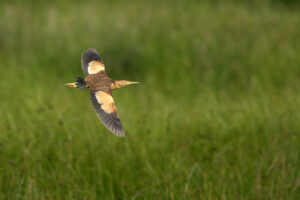Night flight calls of Grey Heron and Purple Heron
NFCs of Grey Heron and Purple Heron are in a different category from those of the three species mentioned above. They differ in having more pronounced croakiness, due to a wider frequency bandwidth. When you make sonagrams from calls recorded at close range, it will be difficult to identify the modal or power-carrying frequency of the call and to decipher harmonics and the fundamental frequency. However, with lower recording quality (eg, at a distance to the bird) the bandwidth shrinks and you begin to discern the core structure, especially in Grey Herons. The pitch of the call seems to be strongly influenced by general agitation. Because of that, it varies strongly in both species. NFCs of Grey Herons are pitched roughly between Black-crowned Night Heron and Little Bittern, and NFCs of Purple Heron are pitched roughly in the area of Little Bitterns. Surprisingly, as a result, Purple can actually be confused at certain times with the most croaky Little Bitterns, especially when viewing sonagrams. The diffuse croakiness of both Grey and Purple should nevertheless always be distinguishable from the accentuated clarity of the three species above, if not by sonagram then at least by ear.
I assume most people are familiar with the rrank flight call of Grey Heron. Although usually very different, there may occasionally be danger of confusion with Black-crowned Night Heron, as both can have generally rising pitch. When Grey Heron uses something similar to a short-distance contact call (eg, a lower pitched, less agitated and quieter call preceding or following a louder one), confusion becomes more likely. Any confusion risk increases with distance. In the following I describe the NFC of Purple Heron only, comparing it to that of Grey Heron.
Grey Heron Ardea cinerea, Hohne, Harz National Park, Germany, 00:10, 22 September 2017 (Lukas Pelikan). Series of rrank calls of a nocturnal migrant over vast spruce forests. Background: Red Deer Cervus elaphus galloping around.

Purple Heron night flight calls
Separating Grey Heron and Purple Heron NFCs is much more difficult than separating the bitterns and night heron. Bandwidth is equally wide and pitch in both Grey and Purple is similar, though Purple tends to be a little higher-pitched. In my experience, most variants of Purple can be readily separated from Grey by ear, and the difficulty centres on a small part of the variation. When the two species become higher-pitched and more strident (probably due to agitation), they tend to sound more similar. I remember a situation where an Ardea heron was approaching us in Bulgaria with strident calls and we first tried to identify it aurally. After we agreed on the identification as Grey we raised our binoculars and, frankly, had to admit it was in fact a Purple. In general, however, the sound of Purple’s krrrk is croakier, more rasping and drier. Lower-pitched calls may even resemble calls of male Garganey Anas querquedula in timbre.
Looking at sonagrams, you will usually see a wide block of a call in either species. In Purple Herons the different harmonics should be merged beyond recognition, whereas in Grey Herons at least part of the call will usually have clearly separated harmonics. As for the croakiness of Purple, sometimes this shows as prominent vertical lines, similar to the ones in a male Garganey’s call. This appears to come from a broader spacing of the particular elements that together make the krrrk call; logically this should sound more rasping.
All in all, the differences are much clearer as soon as you listen to these calls. In fact, some differences that I can hear are not yet visible for me in sonagrams. So it is always safest to listen to a recording thoroughly, likewise with the other species above.
Purple Heron Ardea purpurea, Besh Barmag, Siazan, Azerbaijan, 18:30, 10 October 2017 (Jonas Buddemeier). A rather quick succession of krrrk calls in night flight.


